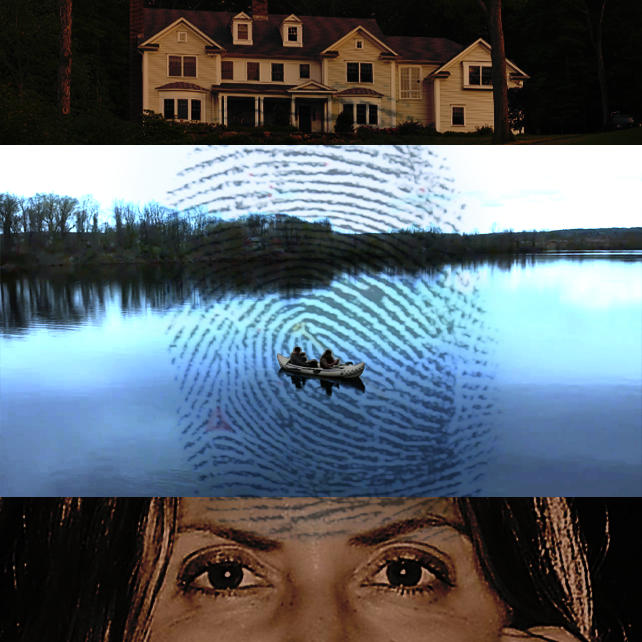In the folklore of nearly every culture, a person who has died violently and whose body has not been found remains trapped between worlds. Until the body is located and laid to rest, the spirit will wander. In distress, a lost soul may now and then recruit some poor schlub, some ordinary Joe, to lead the search for the body.
Jared Vergilis, a Connecticut restaurateur, believes he was tapped for just such a task by the ghost of Jennifer Dulos, the beautiful 50-year-old New Canaan mother of five who was murdered by her estranged husband in her garage six years ago. Though the killer, Fotis Dulos, took his own life before he could be jailed, and though his accomplice, the paramour Michelle Troconis, has been tried and sentenced to 20 years, Jennifer’s body is still missing.
Everyone has a theory. I’ve heard dozens while on tour for my book Murder in the Dollhouse: The Jennifer Dulos Story. There are the professionals—the detectives and lawyers—who say she must be buried in one of two locations: near her New Canaan garage, where police found enough of her blood to prove her murder, or 50 miles to the north, where the physical evidence that implicated Fotis was found in dumpsters on Albany Avenue in Hartford.
“I’ll tell you what happened,” a detective said after my book reading in Stamford. “She was either cut up in pieces and put in those trash cans in Hartford that are emptied into trucks and taken out to the incinerator, meaning she’s smoke. Or the body was handed off to someone in New Canaan, who buried it in the woods—those rich towns are covered in trees.”
As for the amateurs, the would-be sleuths who leave me hand-drawn maps and timelines: they say that since Fotis was a home builder, you will find Jennifer in the foundation of some spec house in Avon, or Simsbury, or in a septic tank, or in one of the rivers that make those central Connecticut towns feel like Mark Twain rambles, or at the bottom of the sort of mountain lake that turns to glass at sundown.
But the most telling theory I’ve heard, and the strangest, comes from the previously mentioned restaurateur, Vergilis, who believes that he and a friend, an Internet psychic named Sean Austin, have narrowed in on the general location of Jennifer’s body by tapping into the etheric plane.
Their story fascinates me not because I believe in their methods—you lose me at “psychic”—but because it suggests an overwhelming need. A need to find Jennifer’s body and achieve that dubious state psychologists call “closure.”
The Spirit Box
Vergilis and I met in May, at a coffee shop in Ridgefield, Connecticut, then spoke again on Zoom, where we were joined by Austin. Austin is a self-described paranormal investigator. He’s appeared on TV shows but gained most of his renown the modern way, online, where an audience of hundreds of thousands live-stream his ghost hunts on TikTok and YouTube. I listened to their story partly in the way of a police procedural and partly in the way of campfire talk. It’s either a real-life ghost story or a perfect example of the sort of hokum that can be sold to those desperate for answers.
On May 24, 2019, when Jennifer Dulos disappeared, Vergilis was running a restaurant in Stamford called Fish Restaurant & Bar. On his way home a few weeks later, he noticed a crush of media gathered in front of the Stamford courthouse. The reporters were waiting for Fotis Dulos and Michelle Troconis to be arraigned.

Transfixed by the story of the missing woman, Vergilis turned to his friend Austin, who had become a clairvoyant relatively late in life. “I skipped a bunch of spiritual pay grades,” he says. “It was like a flip of a switch.” Austin works with a so-called spirit box. About the size of a smart phone, the device is really just a reconfigured AM/FM transistor, but rather than tune in to a single frequency, it quickly cycles back and forth through them all, creating a white noise that, supposedly, allows souls trapped between this world and the next to speak to the living.
Austin decided to sit with his spirit box in front of the house where Jennifer was murdered, on Welles Lane in New Canaan. Now and then, a voice came through the noise, recognizable in the way a face is recognizable in the clouds. He says he heard a woman’s voice—he believed it was Jennifer’s—speaking a handful of clipped phrases: “cut me,” “knife,” “underwater.” Among them were hints that convinced him to head north, to the pond- and creek-filled woods behind the Farmington house where Fotis Dulos had lived first with Jennifer, then with Troconis. Police had been over some of this ground, but much remained unsearched.
Austin and Vergilis found several objects that looked like clues in the woods. A Croc, a handcart, a glove. But in the end, it was less any single item that directed their search than a mood, the way they felt when they stood on the banks of an inlet to the Farmington River, a few thousand yards from the Dulos house at 4 Jefferson Crossing.
There was an abandoned boat launch back there, a concrete ramp that ran into the water where locals used to drop Jet Skis. It was covered in weeds, as was the dirt access road that had been allowed to grow over. The entire area had the chill of abandonment. “It feels like you’re walking through quicksand,” Vergilis told me. “There’s just this bad energy. It’s nasty.”
Austin was live-streaming the search on the now defunct platform Periscope. On the post, which can still be viewed, you see him craning to listen to the spirit box, then see him startle as the white noise of the device gives way to a voice with a Greek accent—you can actually hear this ghostly voice—that sounds a lot like Fotis.
Thousands were watching and listening when that voice scolded Austin, saying, “Warning you!”
“Warning us of what?” asked Austin.
There was a pause, then a different voice said, “Stop looking.”

What can I say about the voice on the spirit box? Was it real? Was it a case of hearing what you want to hear? Or was it bunk cooked up for likes and follows? In any case, the broadcast itself flushed out a clue more revealing than anything else they had found.
Periscope lets users see the names and addresses of everyone who watched. Examining this log, Austin noticed that Michelle Troconis herself had tuned in.
Though out on bail and awaiting trial for conspiracy to commit murder, Troconis, G.P.S. monitor on her ankle, found time to comment about Austin’s live stream on her Instagram page: “In the wake of all that’s been going on I started following @seandaustin and I’m very curious about what he does,” she wrote. “I’ve never believed in spirits but truth is I didn’t even know this type of work existed.”
Troconis describes going on a bike ride through the woods and listening to see “if I heard any kind of voices or spirits” before abruptly pivoting from the subject at hand—the search for Jennifer’s body—to the beauty of Connecticut. “Thanks for showing us this beautiful state!” she signs off with.
Austin noticed that Troconis hadn’t tuned in to all of his videos—just the ones focused on the inlet.
“So,” says Austin, “in our minds, we’re like, What does she know about what’s in the river?”
A Kind of Rorschach Test
Austin got a call from the Connecticut State Police. We’ve seen your videos, said one of the cops. Would you be willing to come out and look with us? Austin and Vergilis agreed, but the inlet, which had become a focus of their search, presented a special problem. Twenty feet deep, weed-choked, murky—how would they ever see what was down there?
Vergilis found a solution in a kayak and a handheld sonar. Mapping the river, he spotted a strange, oblong object resting in the muck at the bottom. Much to Jared’s frustration, a police frogman decided the strange object was probably nothing more than a log and called off a scheduled dive.
A few weeks later, a friend of Vergilis’s named Alex Flynn, a 28-year-old professional scuba diver, turned up for dinner at a New Canaan restaurant, Locali, where Vergilis worked. Flynn has spent hundreds of hours at the bottom of Connecticut’s lakes and rivers, collecting data and rooting out invasive species. Fascinated by Vergilis’s quest, he offered to do a dive for free.
Flynn worked from a 16-foot aluminum skiff, descending and ascending. When he came up the second time, he said he knew just what was down there. A huge floor rug. Flynn said it was “burritoed up,” and weighted down with cinder blocks. It was too big to bring up alone.
Weeks earlier, the detectives, not wanting to draw public attention to the search, had asked Austin to stop live-streaming. But on the day Flynn’s team assembled to recover the rug—September 11, 2023—the cops asked him to go back online. They wanted to see the results without being physically present, in a way that could allow them to deny direct involvement in the project. If the rug turned out to be something important, the detectives could then move in and take over.
However, the state troopers had not planned for the uncontrollable element—the online audience, which swelled furiously as the dive progressed. Here was a real-life mystery unfolding on your phone. By the time the rug, heavy with water, was being pulled up on shore, dozens of locals had turned up at the inlet. News trucks began to arrive.
The rug was carefully unrolled, revealing a large, rust-colored stain. “I was taking off my gear when I heard them say, ‘Oh my God, what the hell is that?’” says Flynn. “The stain looked like an imprint of someone on their side. You could see every single digit on each finger. You could see the thumb, the chin, the head, both elbows. We measured and it was like five foot seven or six.” There was a white line on what looked like an arm. “What’s that?,” I ask Vergilis, who showed me pictures of it. “Where she was zip-tied,” he speculates.

Consider it a kind of Rorschach test. What you see in the rug may say less about the nature of the stain than about what’s in your own mind. Believing is seeing. To Vergilis, the stain suggests Jennifer was carried north in the rug, which he calls “the Shroud of Farmington.” If it was dumped in the river to hide evidence, he says, Jennifer’s body is probably nearby.
The rug was cut into pieces by the police. Vergilis was told these would be sent to a lab for in-depth testing, even though he’d been informed by a trooper at the scene that the rug had been in the water too long for any test to be conclusive. “I asked a trooper how long it was going to take,” Vergilis tells me. “She said anywhere from three days to three weeks.” But the very next morning, Vergilis and Austin woke up to a press release.
“After investigating for several hours, detectives tested several large, irregular brownish-red stains on the rug and a presumptive test determined they were not blood,” the Connecticut State Police said in a statement. “Detectives have found no evidence of the rug being related to any criminal case…. Detectives located numerous rugs in the area and, after speaking with local kayakers, discovered that the rugs are used to launch and retrieve kayaks and to keep vegetation down at this location of the Farmington River.”
Vergilis believed this statement was about misdirection. “Sean and I figured, in the spring, they’d go back out with cadaver dogs and we’d hear that state police had ‘stumbled’ upon something,” Vergilis says. But the months rolled on and nothing more happened.
So, to take it into their own hands, Vergilis and Austin set up a GoFundMe to hire their own cadaver-dog handler—one with 25 years of experience in missing persons and human-remains recovery—who traveled from North Carolina with her dogs for the job. They were joined by a regional handler and her dog team, who sometimes worked with the Connecticut State Police. These teams, sent out separately, both stopped and circled in the same place.
“They gave us two full alerts,” Vergilis tells me. “One dog … even started digging, which signifies, with 98 percent accuracy, the presence of human remains.” Asked what she’d do in such a situation, the regional dog handler told Vergilis, “I’d consider it a crime scene, and an excavator would be on the way.”
At that point, the state police, who’d been in touch via the local dog handler, stepped in. Vergilis expected them to send for ground-penetrating radar to see if anything was buried in the area. The cops did a cursory search instead—they told Vergilis they probed the ground—then declared, as they had with the rug, there was no evidence, nothing to see here.

Vergilis suggests many possible reasons the cops might have backed off. It was April 2024, and the trial of Michelle Troconis was unfolding, and they didn’t want to find anything that might interfere with it; Farmington officials had been spooked by the burst of online attention and wanted to discourage the gawkers; the town had been traumatized by the murder and rather than closure what they really needed to do was to move on; the success of a search led by “civilians” would embarrass the Connecticut State Police, who had spent at least a million dollars trying to find Jennifer and failed. (The Connecticut State Police did not respond to Air Mail’s request for comment.)
Austin moved to North Carolina last year, but for Vergilis, who is another kind of wandering soul, the search continues. When he contacted me, it was because he was out of options. He wants the cops to excavate that last stretch of woods because he’s almost certain they will find Jennifer there. He says he’s motivated by Jennifer’s mother and children and believes healing will begin only when the body is found.
Which is where he loses me. Because I assume, body or no body, they will never heal. Living without answers, in a riddle that can never be solved, is a universal predicament. The Farber and Dulos families just live it more acutely—far more acutely. That’s why we can’t stop thinking about the case.
To me, it does not really matter if they ever find Jennifer’s body. I think of her as a sailor lost at sea, or a soldier buried on a battlefield far from home. It’s not Jennifer that’s lost anyway. It’s her body, from which she was brutally severed. Jennifer was gone before Fotis even made it back to Farmington.
Rich Cohen is a Writer at Large at AIR MAIL


